BIKANER - CITADEL OF CULTURE AND CAMELS
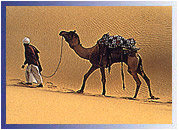
Then
royal fortified city with a timeless appeal. Lying in the north of the Thar
desert state, the city is dotted with many sand dunes.Bikaner retains the
medieval splendor taht pervades the citys life style.
Bikaner's history dates back to 1488 AD when Rathore prince Rao Bikaji a descendant
of the founder of Jodhpur, Rao Jodhaji, estabilshed his kingdom here. Rao
Jodha ji had five sons but Rao Bikaji was the most enterprising of them. Bikaji
chose a barren wilderness called Jangladesh and transformed it to an impressive
city called Bikaner after the founder 's name.
Bikaner is more populary called the camel country, the city is renowned for
the best riding camels in the worlds. The ship of the desert is an inseparable
part of life here. Be it pulling heavy carts, transporting grains or working
on wells, camels are the prime helpers. The wells of Bikaner - an important
source of Water are other attractions of the city. These are built on high
plinths with slender minareted towers on each of the four corners and can
be noticted even from distance.
Bikaner's ‘unspoiled’ ambience of well preserved medieval splendour
is evident and stands on a slightly raised ground and is circumscribed by
a seven km long embattled wall with five gates. The magnificent forts and
palaces created with delicacy in reddish-pink, sandstone, bear testimony to
its historical and architectural legacy. Undulating lanes, colorful bazaars
and bright and cheerful folks make Bikaner an interesting experience.
Places to visit 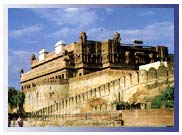 Junagarh Fort
Junagarh Fort
Built in 1593 A.D. by Raja Rai Singh(1571-1611 A.D.), a general in the army
of emperor Akbar, the fort is a formidable structure encircled by a moat and
has some beautiful places within. These places, made in red sandstone (Dulmera)
and marble, make a picturesque ensemble of countryards, balconies, kiosks
and windows dotted all over the structure. The imposing fort has 986 long
wall with 37 bastions and two entrances. The Suraj Pol or sun gate - It is
the main entrance to the fort. Among the noteable of these Palaces are the
beautiful Chandra mahal or Moon Palace with marvellous paintings on the lime
plaster walls, mirriors and carved marble panels and the and Phool mahal or
the Flower palace is decorated with inset mirror work. The gigantic columns,
arches and graceful screen grace the palaces. other palaces wort visiting
are the Anup Mahal, Karan Mahal, Dungar Niwas, Ganga Niwas, Gaj Mandir and
Rang Niwas or or palace of pleasure. The Anoop Mahal is famous for it's gold
leaf painting. Har Mandir- a majestic chapel where the royal family worshiped
there Gods and Goddesses. Karan Mahal was built to commemorate a notable victory
over the Mughal Aurangzeb.The other important important parts are Durbar Hall,
Gaj mandir, Sheesh Mahal or Mirror chamber . Gigantic columns, arches and
graceful screens adron the places.
 Lalgarh
Palace
Lalgarh
Palace
The architectural masterpiece in red stone, the Palace was built by Maharaja
Ganga Singh in the memory of his father Maharaja Lal Singh. The palace has
beautiful lattice work and filigree work. Sprawling lawns with blooming bougainvillea
and dancing pecocks make it a not to be missed visual treat. This oriental
fantasy Designed by Col. Sir Swinton Jacob, is entirely a hybrid architecture
-a mixture of different elements of Rajput, Muslim and European styles and
can be categorized as Indo-Seresanic style. The Rajput exterior of this palace
contrasts dramatically with the occidental decor within. The intricately dexterous
carving on red sandstone is a hallmark of great craftsmanship. The exotic
palace has magnificent pillars, richly carved fire mantles , Italian colonnades
and motif of lotus in full bloom , adding to the magic of this jewel of the
desert. Walls of palaces are reminiscent of the past vintage etchings, hunting
trophies and old portraits. The palace has it's own museum and library (the
fourth largest in the world), clay pigeon trap and skeet shooting traps facilities
at adjoining ranges.
Bikaner royal family still lives in part of the palace. part of the palace
has been converted into a luxury hotel and a museum known as Shri Sadul museum
which was donated by late his highness maharaja Dr. Karni Singhji of Bikaner
to Maharaja Shri Ganga singhji Trust Bikaner in the year 1972 . Princess Rajyashree
Kumari of Bikaner, Chairperson of Trust played a very important role in the
establishment of this museum. The museum covers the entire first floor of
the Lallgarh palace and depicts the lives and times of three successive -
Maharaja Ganga Singh, Sadul Singh and Karni Singh through the various artifacts
and photographs displayed in 22 rooms.
Ganga Golden Jubilee Museum 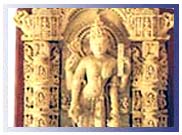
It is the best Rajasthan museum established near the Lalgarh Palace in Bikaner
in 1937 on the eve of the Golden jubilee celebrations of Maharaja Ganga Singh,
this Museum now run by the Government of Rajasthan, was shifted to a new building
in the Civil lines in 1954It is the best Rajasthan museum, having one of the
richest collection of Terracotta ware, weapons, maniature paintings of Bikaner
school and coins. The exhibits are splendid master pieces of Harappan civilisation,
Gupta and Kushan era and sculptures of the late classical time. The museum
hass a seprate section displaying exclusive arts and crafts of the region.
Some principal sections of the museum are:
Maharaja Ganga Singh Memorial, Local Arts and Crafts, History, Sculpture,
Terracotta and Bronzes, Armory, Miniature Paintings and Folk-Arts, Dr. L.P.
Tessitori Memorial Section, Lithoprints of the British interpretation of the
war of Independence 1857.
Camel Research Centre
The National Research Centre on Camel, Bikaner is located in the Jorbeer area
at a distance of about 10 km from Bikaner city. It was established on 5th
July 1984. Prior to that the Centre was known as camel breeding farm under
the aegis of college of Veterinary and Animal Science, Rajasthan Agricultural
University, Bikaner. This one of the largest camel bredding farm in Asia.
The Centre has the responsibility to conduct basic and applied research for
the improvement of camel. Over the years NRCC has developed excellent laboratory
facilities and infrastructure. An elite herd of Bikaneri, Jaisalmeri
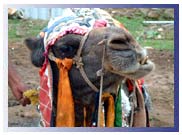
and Kachchhi breed of camel has been developed and maintained at the Centre.
Scientists of the Centre were successful in finding out the genetic variation
within and between camel breeds using molecular markers. The technique of
embryo transfer has been used successfully in producing two camel calves at
the Centre. Extensive studies on evaluation of draughtability of camel breeds
have been carried out by the Centre. The feed requirement during various stages
i.e. lactation, pregnancy, draught has been studied and locally available
feed/fodder resources were evaluated by the Centre. The Centre has also generated
useful information on double humped camel found in Nobra Valley of Laddakh
region.
Bhandaser Jain Temple
The 15 century Temple,is the oldest and distinct monument of bikaner dedicated
to Sumati Nath Ji,the 5th Tirthankar of the Jain Religion.The temple is decorated
with rich mirror work, frescoes and gold leaf paintings..The beautiful temple
was erected near Laxminath temple in 1540A.D.Pure ghee (butter oil) and coconuts
were reported to have been used in laying the foundation. Carved in red sand
stone and white marble - its famous for carvings ,wall paintings , structural
beauty and artistically designed statues
Excursions
Gajner Palace
Gajner Palace -a summer resort of Bikaner Maharajas -has often been described
as ' an incomparable jewel in the Thar desert'. Built by Maharaja Ganga Singh
ji of Bikaner, palace stands on the embankment of a lake .The palace was used
by Maharaja for grand shoots and lavish entertainment. Royalty, both Indian
as well as international, Viceroys and other dignitaries have been entertained
at this grand palace. The architecture of Gajner palace is truly outstanding.
Built in red sandstone with intricately carved pillars, jharokhas and screens
,
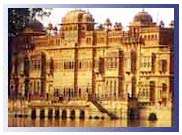
the craftsmanship here is amazing.A part of palace has been transformed into
hotel.
In the 18th century ,when Maharaja Gaj Singh married a Jaisalmer Princess,
she requested him to build a pleasure garden which he proceeded to do, also
creating a tank in the process. This is how Gajner was conceived, and this
was added to by the successive rulers, till maharaja Sardar Singh extended
it into a hunting lodge with an even larger tank. It was this inheritance
that Maharaja Ganga Singh was able to use for diplomatic gains, perfecting
the hunt to a fine art, and contagious with the hospitality with which it
became associated. It was during his rule too that the new Gajner palace was
designed by sir Swinton Jacob, complete with twin dressing rooms per room
to allow couples to get dressed at their own pace. While the annex to the
main palace was opened as a hotel in 1976, the palace too is a hotel now with
25 rooms and a restaurant on the premises.
Gajner Wildlife Sanctuary
The sanctuary is just 32 kms away from Bikaner. Its the perfect place for
adventure lovers to spot the Nilgai, Chinkara, Black buck, Wild boar , flocks
of imperial sand grouse and many more migratory birds. Jeep Safari with a
guide is the best option to visit this wonderful sanctuary.
Deshnok's Karni Mata Temple (Rat Temple)
The famous 600 yrs old temple on the Jodhpur road about 30 kms from the city
dedicated to karni Mata. an incarnation of Goddess Durga. She blessed Rao
Bika, the founder of Bikaner in establishing his kingdom and since then she
was also worshiped as the tutelary deity of the erstwhile Bikaner dynasty.
The temple is unique as the rats called Kabas, are venerated here and the
shrine is a sanctuary for them. It is believed that these Kabas carry souls
of future Charans/bards (children of the goddess) who inhabit the town of
Deshnok. These Kabas are held sacred and they move freely in the temple precincts.
It is considered highly auspicious. It is considered highly auspicious to
sight a white Kaba. The temple has fascinating huge silver gates and marble
carvings that were donated by Maharaja Ganga Singhji The most attractive feature
of temple are the rodents who scamper freely within the premises and if one
touches your feet its considered auspicious. They are regarded sacred and
devotees buy prasad (feeding) to offer to them.
Kolayatji 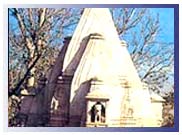
A famous pilgrimage spot with a temple dedicated to Kapil Muni (saint) Kapil
Muni sat in meditation near lake. Muni was propounder of Sankhya Philosophy
The temple is the venue for an annual fair held in the month of Kartik (Oct-Nov)
when the thousands of devotees gather in a large number to take a sacred dip
in the holy waters of the Kolayat lake( Kapil Sarovar) on the full moon day.
Lake is considered to have the effect of washing off the sins of devotees.
A cattle fair ,especially for the trading of camels is a part of he festivities.The
town is connected to Bikaner by road as well as rail.
Katariasar Village
45 kms from the city on Jaipur Road ,the village is rich in ethnic rural and
cultural life.View sunset with typical desert landscape around,walk on a range
of sand dunes and enjoy desert lifestyle.Villagers main profession is cattle
rearing and milk production.the founder of Jasnathi sect of fire dancers-
Jasnathji hail from this very place. Herds of chinkara, desert fox ,rabbit
,peacock, parrot and pat ridges are found in plenty around the village.
Devi Kund Sagar
The Royal crematorium has several exquisite cenotaphs which were built in
memory of the deceased members of the ruling family of Bikaner. The Chhatries
(Cenotaphs) of the early rulers were made of red sandstone, ornamentation
on which resembles very much with carving work on some of the buildings of
Fatehpur Sikri.Maharaja Suraj Singh's Chhatri is the most impressive of all,created
entirely n white marble with spectacular Rajput paintings on the ceiling The
later Cenotaphs were made from marble and very beautifully sculpted and ornamented.Rajput
painting adorn the ceiling of some of the Cenotaphs.
::
Click
here for Reservation
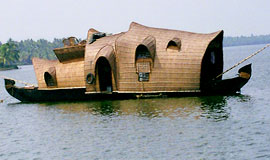
 Then
royal fortified city with a timeless appeal. Lying in the north of the Thar
desert state, the city is dotted with many sand dunes.Bikaner retains the
medieval splendor taht pervades the citys life style.
Then
royal fortified city with a timeless appeal. Lying in the north of the Thar
desert state, the city is dotted with many sand dunes.Bikaner retains the
medieval splendor taht pervades the citys life style. 
 Lalgarh
Palace
Lalgarh
Palace 
 and Kachchhi breed of camel has been developed and maintained at the Centre.
Scientists of the Centre were successful in finding out the genetic variation
within and between camel breeds using molecular markers. The technique of
embryo transfer has been used successfully in producing two camel calves at
the Centre. Extensive studies on evaluation of draughtability of camel breeds
have been carried out by the Centre. The feed requirement during various stages
i.e. lactation, pregnancy, draught has been studied and locally available
feed/fodder resources were evaluated by the Centre. The Centre has also generated
useful information on double humped camel found in Nobra Valley of Laddakh
region.
and Kachchhi breed of camel has been developed and maintained at the Centre.
Scientists of the Centre were successful in finding out the genetic variation
within and between camel breeds using molecular markers. The technique of
embryo transfer has been used successfully in producing two camel calves at
the Centre. Extensive studies on evaluation of draughtability of camel breeds
have been carried out by the Centre. The feed requirement during various stages
i.e. lactation, pregnancy, draught has been studied and locally available
feed/fodder resources were evaluated by the Centre. The Centre has also generated
useful information on double humped camel found in Nobra Valley of Laddakh
region.  the craftsmanship here is amazing.A part of palace has been transformed into
hotel.
the craftsmanship here is amazing.A part of palace has been transformed into
hotel. 